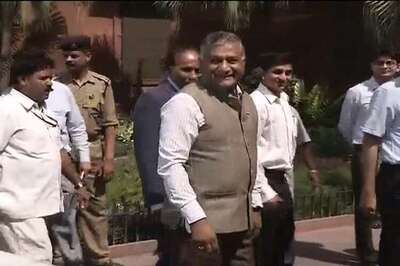
views
The poor, small Southeast Asian country of Laos is set to cede majority control of its electric grid to a Chinese company, as it struggles to stave off a potential debt default, people with direct knowledge of the agreement said.
The deal comes at a time when critics accuse Beijing of “debt trap diplomacy” to gain strategic advantage in countries struggling to repay loans taken out under President Xi Jinping’s global “Belt and Road” infrastructure initiative.
China is Laos’s biggest creditor, and the deal will bind the landlocked, mountainous country of seven million people closer to its giant neighbour.
The power grid shareholding deal was signed on Tuesday between state-owned Electricite du Laos (EdL) and China Southern Power Grid Co., according to Chinese state news agency Xinhua, which did not give details of the new ownership.
Three people with knowledge of the matter said it would give majority control of the new Electricite du Laos Transmission Company Limited (EDLT) to the Chinese company.
Power exports are central to Laos’s development plans.
“It will give the Laos state grid better bargaining power with regional countries and start to make a profit,” said one of the people with direct knowledge of the discussions.
China’s embassy in Laos said on its website that Laos would operate the transmission assets. It did not give shareholding details but said “Laos can also gradually repurchase shares during the operation.”
Neither EdL nor China Southern responded to Reuters requests for comment on the deal. The Laos and Chinese governments did not respond to requests for comment either.
Reporting from the Laos capital Vientiane, Xinhua quoted Laos energy and mines minister Khammany Inthirath as calling it a key project which would benefit from the Chinese company’s “advantages in experience, technology and human resources.”
The new company will operate under Laos government regulation, Xinhua reported, but would take advantage of China Southern’s “financial strength and mature experiences in power grid construction, operation and management.”
The state-run Vientiane Times said after the deal that EDLT would in future invest about $2 billion in the local grid and international connections.
Laos has spent heavily on hydroelectric schemes, many financed by China, with the aim of becoming “The Battery of Southeast Asia”. But those projects, along with a new Chinese high speed railway, are at the centre of a debt crunch.
DEFAULT WARNING
The World Bank estimated in June that debt levels would reach up to 68 percent of GDP in 2020, from 59 percent last year. Rating agency Moody’s warned last month of “a material probability of default in the near term.”
While Laos has recorded only 22 coronavirus cases and no deaths, the epidemic has hit tourism and overseas remittances hard.
Laos debt service obligations in 2020 are around $1.2 billion with loans from commercial banks and Thai bonds maturing in September and October, Moody’s said, but foreign reserves were just $864 million in June, according to the central bank.
Among companies suffering delayed payments already are the Chinese firms behind hydroelectric projects that were not paying back as expected, the people with knowledge of the China Southern agreement said.
China was also considering postponing part of Laos’ total debt service payments, two people with direct knowledge said. China’s government did not immediately respond to a question on the discussions.
“Economically Laos is going to depend more on China and this is inevitable,” said Toshiro Nishizawa, a Japanese professor who has advised the Laos government on fiscal stability.
Laos could be eligible for help by the International Monetary Fund under its COVID-19 Financial Assistance and Debt Service Relief response, from which 80 countries are benefiting, two Western diplomats said.
But they said it had made clear it would rather try to find a solution with China, they said. An IMF deal would require greater financial transparency.
Total Chinese investment in power, transport, a border economic zone and other projects already totals over $10 billion, according to Xinhua citing figures from Laos. That is more than double investment by Thailand, the next biggest.
A study published in 2019 by the Australia-based Lowy Institute put Laos debt to China at 45 percent of GDP.
The economic relationship with Beijing has also strengthened political ties, with Laos a reliable backer of China’s position on matters such as the South China Sea in the regional Association of Southeast Asian Nations.
Laos was the first country to endorse Chinese leader Xi’s political message of “building of community of common destiny”.
“Giving China a major stake in the ‘Battery of Southeast Asia Plan’ puts Laos fast on the track of becoming a pseudo-province of China,” said Brian Eyler, Southeast Asia programme director of the Stimson Center think-tank in Washington.
(Additional reporting by Panu Wongcha-Um; Editing by Matthew Tostevin & Simon Cameron-Moore)
Disclaimer: This post has been auto-published from an agency feed without any modifications to the text and has not been reviewed by an editor




















Comments
0 comment